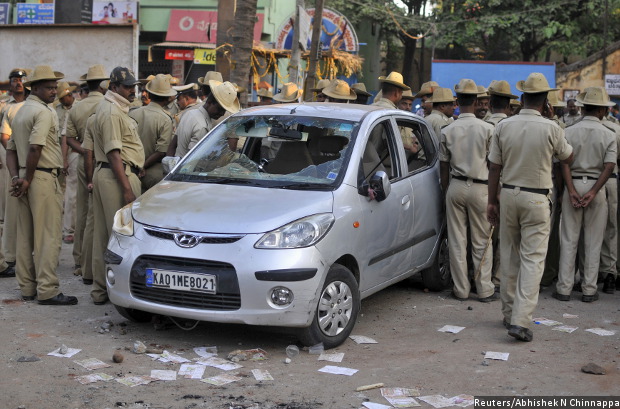3 Reasons Bengaluru Textile Workers Rioted
Policemen stand next to a damaged vehicle after a protest by garment workers in Bengaluru on Tuesday.
Bengaluru's garment workers--about half a million of them, mostly women--have no pensions, job security, health insurance and live life close to the poverty line. This hitherto silent mass was suddenly agitated by a central government order to restrict early withdrawals from the Employee Provident Fund (EPF), a financial security net.
Thousands blocked arterial roads, causing snaking traffic jams, and as the protests escalated into rioting, burnt vehicles and police firing, the Centre suspended the decision to restrict EPF withdrawals.
The Employee Provident Fund has been around since 1951, a law passed by India's Parliament, requiring employees to contribute a fixed proportion of salary to their EPF account, with the employer matching this contribution. Here's how it works:
The employee earns an interest of 8.75% compounded annually on the money accumulated in her EPF account.
Contribution by the employer is tax-free. The contribution by the worker is taxed. But the savings withdrawn later are not taxed.
In this year’s budget, Finance Minister Arun Jaitley announced that EPF would be taxed when claimed--to prevent savings from being used before retirement--a move he had to rollback. People did not want the government denying them access to their savings.
There are 65.6 million active EPF accounts-- both public and private sector--according to this August 2015 Employee Provident Fund Office (EPFO) newsletter.
Here are three reasons why Bengaluru's garment workers rioted:
1) Restrictions on withdrawing EPF savings
Until the controversial order, workers could withdraw all their EPF money, with interest, if they were unemployed.
Now, EPF holders cannot withdraw all their money for marriage, education of children, serious illnesses and buying property, according to this notification issued on February 10, 2016.
The order was a blow to garment workers, who need money at intervals for precisely the reasons mentioned above.
2) Withdrawal on retirement, now delayed by three years
The new order says you can withdraw all your EPF money only at retirement, the age of which has been increased from 55 to 58. This rule has now been suspended until July 31, 2016.
3) 92% private-sector retirees have no pension, health insurance
India's formal, or organised, workforce comprises 28.9 million workers, with secure employment, pension and medical benefits. Of these, 40% (11 million) work in the private sector, according to government estimates.
In general, public-sector employees enjoy better and more regular pensions, health benefits and income security than private-sector workers.
The 40% private-sector employees we referred to are only those the government’s statistical agencies categorise under the organised sector. Of these, 92% have no income security, pensions or health insurance, an IndiaSpend analysis has shown. Garment workers are among this insecure population, which needs regular access to EPF accounts for vital life needs.
The growing distress of India's unorganised workforce
While many private-sector workers, such as those in the garment industry, lead precarious lives, they are better off than their compatriots in the unorganised sector.
“Unorganized workers consist of those working in the unorganized sector or households, excluding regular workers with social-security benefits provided by the employers and the workers in the formal sector without any employment and social security benefits provided by the employers,” according to this government definition.
About 72% (340 million of 472 million) of India's workforce was in the unorganised sector at the end of 2011-12, as IndiaSpend has reported.
Much like workers in the private sector, those in the unorganised sector also depend on money from EPF accounts--if at all they have such accounts--to get by.
(Tewari is an analyst with IndiaSpend.)
We welcome feedback. Please write to respond@indiaspend.org. We reserve the right to edit responses for language and grammar.
__________________________________________________________________
Liked this story? Indiaspend.org is a non-profit, and we depend on readers like you to drive our public-interest journalism efforts. Donate Rs 500; Rs 1,000, Rs 2,000.



